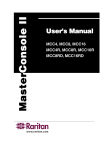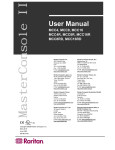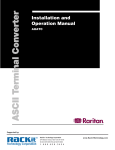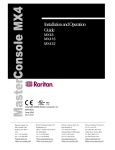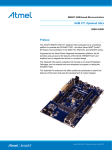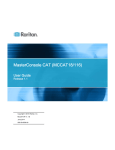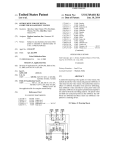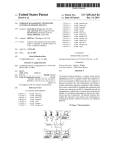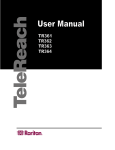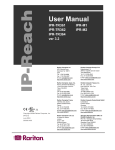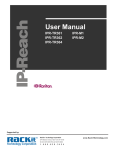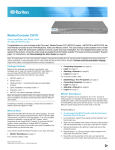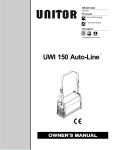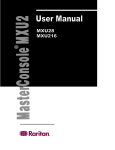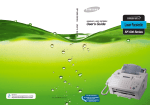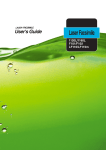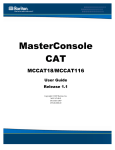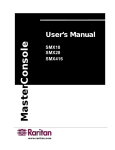Download User`s Manual
Transcript
User’s Manual MCC4, MCC8, MCC16 MCC4R, MCC8R, MCC16R MCC8RD, MCC16RD User’s Manual MCC4, MCC8, MCC16 MCC4R, MCC8R, MCC16R MCC8RD, MCC16RD Copyright © 1999 Raritan Computer, Inc. Ver. 0C, AUG, 2000 Raritan Computer, Inc. 400 Cottontail Lane Somerset, NJ 08873 U.S.A. Tel. 1-732-764-8886 Fax 1-732-764-8887 E-mail [email protected] http://www.raritan.com Raritan Computer Europe, B.V. Eglantierbaan 16 2908 LV Capelle aan den IJssel The Netherlands Tel. 31-10-284-4053 Fax 31-10-284-4049 E-mail [email protected] http://www.raritan.com Raritan Computer Japan, Inc. Kuga Building 7F, 11-6 Kuramae 4-chome Taitoo-Ku Tokyo 111-0051, Japan Tel. 81-3-5833-6360 Fax 81-3-5833-6336 Email [email protected] http://www.raritan.com Raritan Computer Taiwan, Inc. 5F,121,Lane 235,Pao-Chiao Rd, Hsin-Tien City,Taipei Hsien Taiwan,ROC Tel. 886-2-8919-1333 Fax 886-2-8919-1338 E-mail:[email protected] http://www.raritan.com FCC Information This equipment has been tested and found to comply with the limits for a Class A digital device, pursuant to Part 15 of the FCC Rules. These limits are designed to provide reasonable protection against harmful interference in a commercial installation. This equipment generates, uses and can radiate radio frequency energy and, if not installed and used in accordance with the instructions, may cause harmful interference to radio communications. Operation of this equipment in a residential environment may cause harmful interference. Product names mentioned in this document are trademarks or registered trade4 marks of their respective companies. MasterConsole MX , MasterConsole, and their respective logos are registered trademarks of Raritan Computer, Inc. PS/2, RS/6000, and PC/AT are registered trademarks of the International Business Machines Corporation. Mac is a registered trademark of Apple Computer, Inc. Sun is a registered trademark of Sun Microsystems. Alpha is a registered trademark of Digital Equipment Corporation. HP9000 is a registered trademark of Hewlett Packard. SGI is a registered trademark of Silicon Graphics, Inc. Japanese Approvals Table of Contents FCC INFORMATION I TABLE OF CONTENTS II TABLE OF FIGURES III WELCOME 1 OVERVIEW 1 FEATURES 1 ONE-TIER AND TWO-TIER CONFIGURATIONS 2 GETTING STARTED 3 ONE-TIER CONFIGURATION 4 INSTALLING MASTERCONSOLE II (ONE-TIER) 4 CONFIGURING MASTERCONSOLE II (ONE-TIER) 6 ASSIGNING NAMES AND SCAN RATES (ONE-TIER) 8 USING MASTERCONSOLE II SECURITY FEATURE (ONE-TIER) 10 Passwords 10 Turning Security on/off and Changing Passwords: 10 OPERATING MASTERCONSOLE II USING ON-SCREEN USER INTERFACE (ONE-TIER) 12 Selecting a Computer 12 Setting AutoScan 14 OPERATING MASTERCONSOLE II USING FRONT PANEL BUTTONS (ONE-TIER) 14 TWO-TIER CONFIGURATION 16 INSTALLING MASTERCONSOLE II (TWO-TIER) 16 Install Base Unit (First-Tier) MasterConsole II 16 Connect Second-Tier MasterConsole(s) to the Base Unit 17 Connect Computers to Second-Tier MasterConsole(s) 18 CONFIGURING THE BASE MASTERCONSOLE II (TWO-TIER) 19 ASSIGNING NAMES AND SCAN RATES (TWO-TIER) 21 USING THE MASTERCONSOLE II SECURITY FEATURES (TWO-TIER) 23 OPERATING MASTERCONSOLE II (TWO-TIER) 23 Selecting a Computer 23 REMOTE ACCESS USING CAT5 REACH 27 APPENDICES 28 SYSTEM DEFAULT SETTINGS 28 ON-SCREEN USER INTERFACE FUNCTION KEYS 29 MASTERCONSOLE CONFIGURATIONS AND PROGRAMMING MASTERCONSOLE II AT POWER UP 30 MasterConsole II product Design Background and Considerations 30 Programming MasterConsole II 30 MASTERCONSOLE II CONFIGURATION DIAGRAMS 31 GLOSSARY 34 TROUBLESHOOTING 38 SPECIFICATIONS 41 Main Unit 41 Universal Cable Kits 42 Accessories 42 Remote Access Kit 42 TABLE OF FIGURES FIGURE 1. ONE-TIER CONFIGURATION 2 FIGURE 2. TWO-TIER CONFIGURATION (WITH OPTIONAL REMOTE ACCESS) 2 FIGURE 3. MASTERCONSOLE II BACK PANEL 4 FIGURE 4. ONE-TIER CONFIGURATION CABLING DETAILS 5 FIGURE 5. CABLE ADAPTERS TO CONVERT PS/2 TO AT 5 FIGURE 6. MASTERCONSOLE II FRONT PANEL 6 FIGURE 7. MASTERCONSOLE II FRONT PANEL (CHANNEL LIGHTS) 6 FIGURE 8. CONFIGURATION MENU 6 FIGURE 9. EDIT NAMES AND SCAN RATE MENU (ONE-TIER) 9 FIGURE 10. ADMINISTRATION MENU 11 FIGURE 11. SELECTION MENU (ONE-TIER, SORTED BY CHANNEL ID) 12 FIGURE 12. TWO-TIER CONFIGURATION (WITH OPTIONAL REMOTE ACCESS KIT) 16 FIGURE 13. TWO-TIER CONFIGURATION CABLING DETAILS 17 FIGURE 14. CONFIGURATION MENU (TWO-TIER) 19 FIGURE 15. DEVICE TYPES 20 FIGURE 16. DEVICE FIELD 20 FIGURE 17. DEFAULT MASTERCONSOLE II CHANNEL IDS AND NAMES 21 FIGURE 18. EDIT NAMES AND SCAN RATE MENU (BASE MASTERCONSOLE II) 22 FIGURE 19. EDIT NAMES AND SCAN RATE MENU (SECOND-TIER MCC8) 23 FIGURE 20. SELECTION MENU (TWO-TIER, BASE MASTERCONSOLE II) 25 FIGURE 21. SELECTION MENU (TWO-TIER, SECOND TIER) 26 FIGURE 22. REMOTE ACCESS WITH CAT5 REACH 27 FIGURE 23. TWO-TIER CONFIGURATION WITH SATELLITE UNIT 27 FIGURE 24. BASIC ONE-TIER CONFIGURATIONS 31 FIGURE 25. ONE-TIER WITH REMOTE ACCESS KIT 31 FIGURE 26. TWO-TIER CONFIGURATION OF UP TO 256 COMPUTERS 32 FIGURE 27. TWO-TIER CONFIGURATION WITH MASTERCONSOLE P MODEL 32 FIGURE 28. TWO-TIER CONFIGURATION WITH SATELLITE UNIT 33 1 Welcome Overview Raritan's keyboard/video/mouse (KVM) switches are engineered to provide reliable, cost-effective, central control of multiple computers. This eliminates the cost and clutter of unnecessary equipment, reclaims space, and improves productivity for a host of applications. MasterConsole II enables control of any mix of 2 to 256 computers from a single keyboard, monitor, and mouse. MasterConsole II user interface provides simple on-screen control and system management. Raritan's unique emulation technology dedicates a keyboard/mouse emulator for each computer to ensure that each computer always 'sees' its own keyboard and mouse. This means smooth, flawless switching and operation, even when computers are running the most demanding operating systems. Features · Models for 4, 8, or 16 computers · Mix any brand PCs, Macs, Suns, Alphas, RS/6000s, HP9000s, SGIs · “Keep-alive” emulation ensures non-stop computer operation in the event of power loss to the switch · High resolution video-1600x1280 · Tangle-proof, double-shielded coaxial cable from 6.5, to 30 feet · On-screen user interface for simple control and system management · Assign meaningful names to computers for quick identification and selection · Operate with front panel buttons or hot-keys with on-screen menus · AutoSkip function to bypass inactive channels · AutoScan computers at variable rates · Password Security to ensure authorized access to computers · Optional Dual Remote access capability with Cat5 Reach · Compatible with MasterView ready MasterConsole P Models (MCPn) 4 · Cascade from a multi-user MasterConsole MX · One year warranty for parts and labor 2 One-Tier and Two-Tier Configurations MasterConsole II can be configured in one or two tiers, depending on the number of computers you want to control. In a one-tier configuration, only computers are connected to a single MasterConsole II unit. See Figure 1. In a two-tier configuration, either a computer or another MasterConsole unit is connected to each channel of the base MasterConsole II unit. See Figure 2. Figure 1. One-Tier Configuration Figure 2. Two-Tier Configuration (With optional Remote Access) 3 Getting Started MasterConsole II is designed for quick, easy installation and operation. Follow the steps for either one-tier or two-tier configuration to be up and running within minutes: 1. Install MasterConsole II (connect computers). 2. Configure MasterConsole II. 3. Assign computer names and set channel-specific Scan Rates for attached computers. 4. Turn ON security and change passwords if you want to restrict access to computers connected to MasterConsole II. 5. Operate using On-Screen User Interface or front panel buttons. 6. Install optional Cat5 Reach for remote console or satellite unit. Quick-Start Operation After you connect computers to your MasterConsole II you may wish to explore MasterConsole II operation with the default names and parameters. You may operate using the front panel buttons and/or the On-Screen User Interface. To activate On-Screen User Interface, press the <ScrollLock>> key twice rapidly. The Selection Menu will appear. To select a computer, use the <Ï>/<Ð> keys to highlight the desired channel (computer) and press <Enter>or press the desired computer's Key number (located in the left-hand column). To select another computer, use front panel buttons or re-activate the On-Screen User Interface. 4 One-Tier Configuration Installing MasterConsole II (One-Tier) 1. Shut down and power off all computers to be connected to MasterConsole II. 2. Plug a keyboard, monitor, and mouse into the keyboard, monitor, and mouse ports on the MasterConsole II back panel. See Figure 3 and Figure 4. 3. Power ON the MasterConsole II unit. 4. Using a universal cable kit (CCPnnU), plug the 25-pin connector into one of the numbered channels on the MasterConsole II back panel. 5. Plug the cable's other connectors into the computer's keyboard, monitor, and mouse ports. Use supplied adapters for AT style PCs. See Figure 5. 6. Power ON the connected computer. 7. Select the connected computer by pressing the corresponding front panel button. Verify that the monitor attached to MasterConsole II displays the video for the connected computer. Use the keyboard and mouse attached to MasterConsole II to verify that they operate the connected computer. Note: An amber channel light above a numbered channel button on the MasterConsole II front panel indicates that the channel is active; that is, a computer is connected and powered on. A green light above a numbered channel button indicates the cur rently displayed channel. See Figure 6 and Figure 7. 8. Repeat Steps 4 through 7 to connect the remaining computers to MasterConsole II. Figure 3. MasterConsole II Back Panel 5 Figure 4. One-Tier Configuration Cabling Details Figure 5. Cable Adapters to convert PS/2 to AT 6 Figure 6. MasterConsole II Front Panel Figure 7. MasterConsole II Front Panel (Channel lights) Configuring MasterConsole II (One-Tier) The Configuration Menu is used to specify your MasterConsole II configuration and to set/change operation parameters. 1. Activate On-Screen User Interface by pressing the hot-key (<ScrollLock> by default) twice rapidly. Configuration Menu Connected: 01 PC0001 Model: MCC8 Name: MCC8 Device: . . . . . . . . Scan: Off Set: 15 Seconds Mode: Global Skip: On ID Display: 20 Seconds Hot Key: Scroll Lock Display Position: Menu ID Green Mode: Off 15 Minutes Previous Channel Key: CapLck F1 F2 F3 F4 F5 F6 F7 Esc Figure 8. Configuration Menu 7 2. Press <F4> to access the Configuration Menu. See Figure 8. · The Connected field displays the Channel ID and Name of the currently selected computer. · The Model field displays the model number of this MasterConsole unit. 3. Use the <Tab> (forward)/<Shift-Tab> (backward) keys to highlight the desired field and make your changes as follows: · To change Name (default is the unit’s model number): Move to Name and type a name up to five characters. This field is used for your identification purposes only. · The Device field specifies the type of device connected to each channel. The default character is ".", which indicates that the device is a computer. In a one-tier configuration, only a computer may be connected to each channel. The Device field settings may be changed when expanding to a two-tier configuration. See Figure 15, page 19 for two-tier device type settings. · To turn AutoScan ON/OFF (default is OFF): Move to Scan and press the <Ï>/<Ð> keys to toggle. If you exit On-Screen User Interface with AutoScan ON, MasterConsole II will scan according to the currently set mode (Individual/Global) and scan rate. a. a. To change the Global Scan Rate (default is 3 seconds): Move to Set and type a number from 01 to 99, or press the <Ï>/<Ð> keys to specify the Scan Rate (in seconds) for Global AutoScan. b. To change AutoScan mode (default setting is Global): Move to Mode and press the <Ï>/<Ð> keys to toggle between Global and Individual. See page 34 for description. · To turn AutoSkip ON/OFF (default is OFF): Move to Skip and press the <Ï>/<Ð> keys to toggle. With AutoSkip ON, only active channels can be selected. · To change the ID Display time interval (default is 3 seconds): Move to ID Display and type a number from 01 to 99, or press the <Ï>/<Ð> keys to specify the interval (in seconds) you want the Channel ID and Name to display when each computer is selected. Type 99 if you want the Channel ID and Name to display continuously. · To change the On-Screen User Interface activator (default is <Scroll Lock>): Move to Hot Key and press the <Ï>/<Ð> keys to select the desired key. The hot-key can only be <ScrollLock> <NumLock>, <CapsLock>, left <Shift> or left 8 <Alt>. · To change the Menu Display position: Move to Menu and press <Enter>. Then press the <Ï>, <Ð>, <Í>, and <Î> keys to move the menu vertically and horizontally to the desired position. Then press <Esc> or <Enter>. · To change the Channel ID display position: Move to ID and press <Enter>. Then press the <Ï>, <Ð>, <Í>, and <Î> keys to move the menu vertically and horizontally to the desired position. Then press <Esc> or <Enter>. · To turn PowerSave ON/OFF (default is OFF): Move to Green Mode and press the <Ï>/<Ð> keys to toggle. To change the PowerSave delay time (default is 15 minutes): Move to the next field and type a number from 01 to 99, or press the <Ï>/<Ð> keys to change the interval (in minutes) of inactivity (no keyboard or mouse operation) after which the video signal will be cut off from the monitor. This will allow a properly equipped monitor to enter low-energy mode. · To select Previous Channel Toggle (default is CapsLock). This feature enables the user to toggle between the previous and current selected channel. Press F4 to display the Configuration menu (Figure 1) and move the cursor to the Previous Channel Key. Use the <-> or <¯> keys to select the key, <caps lock>, <scroll lock>, <num lock>, left <shift>, or left <alt> to be used. This feature enables the user to switch back to a previous channel by pressing the selected key twice rapidly. There is no need to activate the OSUI. NOTE: Select a previous channel key that is not being used as the current hot key activator. 4. To exit the Configuration Menu: Press an appropriate Menu F key to go to another menu, or press <Esc> to exit On-Screen User Interface and return to normal computer operation. Any changes made to the Configuration Menu are automatically saved. Assigning Names and Scan Rates (One-Tier) You may assign meaningful names to quickly and easily identify and select connected computers. By default, the channel name is PC00aa (where aa is the channel ID number) and the Channel-Specific Scan Rate is 3 seconds. 1. Activate On-Screen User Interface. 9 2. Press <F3> to access the Edit Names and Scan Rate Menu. See Figure 9. 3. Use the <Tab>, <Shift-Tab> or <Ï>/<Ð> keys to move the cursor to the line you want to edit. Use <Í>/<Î> to move within a line. · To change the Name: Type up to 8 characters (no spaces). · To change the Channel-Specific Scan Rate (default is 3 sec- onds): Type a number from 00 to 99 (seconds). When the AutoScan Mode in the Configuration Menu is set to Individual, these Channel-Specific Scan Rates are enabled. If the AutoScan mode is set to Global, the global value will be used. 4. When you move to a different page or exit this Menu, you are prompted to save your changes. Press <Y> to save. 5. To exit the Edit Names and Scan Rate Menu: Press any Menu F key to go to another menu, or press <Esc> to go to the Selection Menu. Note: If your MasterConsole II is a 16-channel model, MCC16, use the <Page Up>/<Page Down> keys to view the next or previous group of eight channels. Edit Names and Scan Rate MC: MCC8 Page: 1 / 1 Ch. ID Name Scan Rate ............ ................. .................... 01 PC0001 05 02 Sara 03 03 Sales-2 10 04 Bob 04 05 PC0005 06 06 PC0006 08 07 Market-4 03 08 JoePC 02 ............ ................. .................... F1 F2 F3 F4 F5 F6 F7 Esc Figure 9. Edit Names and Scan Rate Menu (One-Tier) 10 USING MASTERCONSOLE II SECURITY FEATURE (ONE-TIER) You can restrict access to MasterConsole II. The Administration Menu is used to turn security on/OFF and to change the Administrator's Password and the five authorized user passwords. Up to six passwords can be defined - one Administration Password and five User Passwords. Note: If security is ON, and the system remains idle (no keyboard, mouse, or front panel operation for a time interval set by the user-default is 15 minutes), the next user must enter a user password to establish access. By default, MasterConsole II operates with security OFF. Passwords Only the Administrator's password provides access to the Administration Menu, which is accessed to turn security on/off and to change passwords. If you use the security feature, be sure to record and store passwords where they will be handy to you and other authorized users. MasterConsole II is delivered with system default passwords. They are Admin User 1 User 2 User 3 User 4 User 5 Password Raritan 111 222 333 444 555 as follows: Turning Security ON/OFF and Changing Passwords: 1. Activate On-Screen User Interface. 2. Press <F5> to access the Administration Password prompt. 3. Type in the Administration Password, then press <Enter>. · The Administration Menu will be displayed. See Figure 10. 4. Use the <Tab> (forward)/<Shift-Tab> (backward) keys to move 11 the cursor to the desired field and make your changes as follows: · To turn Security ON/OFF (default is OFF): Press the <Ï>/<Ð> keys to toggle. · To change Security activation delay time (default is 15 minutes). Move to the Time Out field, then type a number from 01 to 99, or use the <Ï>/<Ð> keys to specify a time interval. If the system will remains inactive (no keyboard or mouse operation) for this time interval, the next user is required to enter a password to access the MasterConsole II. · To change the Administration Password: Move to Change Passwords, where Admin will be highlighted. Press the <Enter> key and type a new password (up to eight alphanumeric characters, no spaces). Press <Enter>. Confirm the password by typing it again. Press <Enter>. · To change a User Password, press the <Tab> key to highlight one of the desired Users. Press <Enter>. Type a new password (up to eight alphanumeric characters, no spaces). Press <Enter>. Confirm the password by typing it again. Press <Enter>. Repeat this process for the remaining four Users, pressing the <Tab> key to move from one User field to the next. You can specify up to five User Passwords. · To change the type of keyboard, press the <Tab> key to highlight Language Mode field. Press <Ï>/<Ð> to select English, German, or French. Administration Menu Security: On Time Out: 15 Minutes Change Passwords: Admin User3 User1 User2 User4 User5 Language Mode: English F1 F2 F3 F4 F5 F6 F7 Esc Figure 10. Administration Menu 12 5. To exit the Administration Menu: Press any Menu F(function #) key to go to another menu or press <Esc> to exit on-screen user interface and return to normal computer operation. Operating MasterConsole II Using On-Screen User Interface (One-Tier) Selecting a Computer 1. 2. Activate On-Screen User Interface by pressing the hot-key twice rapidly. · AutoScan is suspended, if set. · MasterConsole II front panel buttons are disabled. · The Selection Menu is displayed. See Figure 11. The Selection Menu lists channels sorted either by Channel ID or alphabetically by Name. Default sorting is by Channel ID. Press <F12> to toggle between Channel ID and alphabetical. · The Selection Menu displays a maximum of eight channels at a time. · The Status column shows each channel's activity and ChannelSpecific Scan Rate. A "+" in the first column indicates a device is connected and powered ON, while a "-" indicates the device is powered OFF or there is no device connected. "Snn" indicates the Channel-Specific Scan Rate of nn seconds. (default is 3 seconds). Selection Menu MC: MCC8 Page: 1 / 1 Key Ch ID Name Status ....... ............... ............... ............ 1 01 2 02 3 03 4 04 5 05 6 06 7 07 8 08 ....... ............... F1 F2 F3 F4 +S05 +S03 +S10 +S04 -S06 -S08 +S03 Market-4 +S02 JoePC ............... ............ F5 F6 F7 Esc PC0001 Sara Sales-2 Bob Figure 11. Selection Menu (One-Tier, sorted by Channel ID) 13 As the computer status changes (active/inactive), the MCC updates the Status column periodically. To enable a user to see the new status immediately, activate the OSUI and press F8Upgrade Computer Status. The MCC will scan the channels and update the computer status and then return to the previous menu. · For any inactive channel, the ID bar will display only the channel ID and not the name field, when sorted by channel and will not display anything when sorted by name-F12 toggle. The non-displayed names are still available in the MCC internal database and can be edited with the F3 function. 3. To select a computer: · Use the <Page Up>/<Page Down> or <Ï>/<Ð> keys to highlight the desired computer and press <Enter>; OR · When the Selection Menu is sorted by Channel ID, press the desired computer's Key number (shown in the left-hand column); OR · When the Selection Menu is sorted by Name (arranged alphabetically), use the <Page Up>/<Page Down> or <Ï>/<Ð> keys, or type the first character(s) of the desired Name to quickly jump to the Name that most closely matches what you type. To back up a character, press the <Backspace> key. Highlight the desired computer, and press <Enter>. · When you select a computer, you automatically return to normal computer operation at the selected computer. · The light above the selected Channel button turns from amber to green, and the monitor displays video from the selected computer. · The Channel ID and Name will be displayed on the monitor for the time interval specified in the Configuration Menu. · Press <Home> at any time to return to the first page of the Configuration Menu (for 16-channel or two-tier systems). Note: See Appendix page 27 for a list of other Function Keys and how to use them. 14 Setting AutoScan · AutoScan activation shortcut:Activate the On-Screen User Interface and press the F6 Function Key. The green light next to the <Scan> button on the front panel will be ON and the unit will scan according to the parameters set in the Configuration Menu. Operating MasterConsole II Using Front Panel Buttons (One-Tier) When the on-screen user interface is not activated, you can operate MasterConsole II from the front panel. The front panel has a <Scan> button, a <Skip> button, and a series of numbered buttons used to select channels and to set the Global Scan Rate. See Figure 6 and Figure 7. 1. To select a computer: · Be sure the green light next to the <Scan> button is OFF (toggle ON/OFF). · Press the numbered button corresponding to desired channel. · The light above the selected Channel button turns green, video from the selected computer displays on screen and you may now operate the selected computer. · The Channel ID and Name will be displayed on the screen for the time interval specified in the Configuration Menu. 2. To activate AutoScan: · Press the <Scan> button (toggle ON/OFF) The green light next to the <Scan> button will be ON and the unit will scan according to the parameters set in the Configuration Menu. If the AutoScan Mode is set to Individual, AutoScan will occur at the Channel-Specific Scan Rates as defined in the Edit Names and Scan Rate Menu. 15 3. To change the Scan Rate: · While AutoScan is ON, press the numbered button corresponding to the desired Scan Rate located above the front panel channel light to set the Global Scan Rate. If the Scan Mode in the Configuration Menu had been previously set to Individual, it will be reset to Global after the front panel button is pressed. 4. To activate AutoSkip: · Press the <Skip> button (toggle ON/OFF). The green light next to the Skip button will be ON and only active channels will be selected. 16 Two-Tier Configuration You may cascade MasterConsole II units to create a two-tier configuration. In a two-tier configuration, a mix of devices-computers and MasterConsoles-may be connected to the channels of the first tierreferred to as the base MasterConsole II. See Figure 12. The second-tier MasterConsole may be any combination of MasterConsole IIs, or MasterConsole P Models, which may be banked. Only computers may be connected to the channels of the any second-tier MasterConsole. Figure 12. Two-Tier Configuration (With optional Remote Access Kit) Installing MasterConsole II (Two-Tier) Install Base Unit (First-Tier) MasterConsole II 1. Plug the keyboard, monitor, and mouse into the keyboard, monitor, and mouse ports on the MasterConsole II back panel. See Figure 13. 2. Power ON the MasterConsole II base unit. 3. Connect computers to any Channels on the base MasterConsole II back panel. a. Shut down and power off all computers to be connected to the base MasterConsole II. 17 b. Using a Universal cable kit (CCPnnU), plug the 25-pin connector into one of the numbered Channels on the base MasterConsole II back panel. c. Plug the cable's other connectors into the computer's keyboard, monitor, and mouse ports. Use supplied adapters for AT style PCs. See Figure 5. d. Power ON the connected computer. e. Select the connected computer by pressing the corresponding front panel button. Verify that the monitor attached to MasterConsole II displays the video for the connected computer. Use the keyboard and mouse attached to the base MasterConsole II to verify that they operate the connected computer. f. Repeat Steps 3.a through 3.e to connect additional Figure 13. Two-Tier Configuration Cabling Details computers to the base MasterConsole II. Connect Second-Tier MasterConsole(s) to the Base Unit 4. Connect MasterConsole(s) to any Channel(s) of the base MasterConsole II. 18 a. Using a Universal cable kit (CCPnnU), plug the 25-pin connector into one of the numbered Channels on the base MasterConsole II back panel. b. Plug the cable's other connectors into the Keyboard, Monitor, and Mouse ports of the second-tier MasterConsole II or MasterConsole P Model. c. Power on the MasterConsole unit according to the follow- Note: All second-tier MasterConsole P Models must be MasterView ready. To determine if your P Model does have this feature, check the white label on the bottom of the unit *. This label shows the unit's level and style of firmware: MDSP-nnn. If it is MDSP-1AC or higher (MDSP-1AD, etc.), the unit is MasterView ready. If not, you need to upgrade. Call Raritan Technical Support for details. ing instructions: · IMPORTANT: For MasterConsole II, the unit must be programmed as a second-tier unit. (The default setting is first-tier) To program any MasterConsole II as a second-tier unit, power ON while pressing the Channel #2 button on the front panel and hold for 3 seconds. When the unit is programmed as a second-tier unit, the LED on the far right of the unit's front panel (2ND) will be lit continuously. Note: Any unit can be re-programmed to be a first-tier unit by pressing the Channel #1 button on the front panel during a subsequent power ON process. · For MasterConsole P Model: Turn the power switch on. d. Repeat steps 4a through 4c to connect additional secondtier MasterConsole units to the base MasterConsole II. e. For second-tier units located more than 30 feet away from the base unit, see Remote Access Using Cat5 Reach, page 25. Connect Computers to Second-Tier MasterConsole(s) 5. Connect computers to the channels of second-tier MasterConsole(s). · Follow Steps 3a through 3f to connect the computers to each second-tier MasterConsole II. · For MasterConsole P Models, follow installation instructions in the P Model manual. 19 Configuring the Base MasterConsole II (Two-Tier) The Configuration Menu is used to specify your base MasterConsole II configuration and to set/change parameters for operation. See Figure 14 1. Activate On-Screen User Interface by pressing the hot-key (<Scroll-Lock> by default) twice rapidly. 2. Press <F4> to access the Configuration Menu. · The Connected field displays the Channel ID and Name of the currently selected computer. · The Model field displays the model number of this MasterConsole unit (MCCn). 3. Use the <Tab> (forward)/<Shift-Tab> (backward) keys to select the desired field and make your change as follows: · To change Name (default is the unit's model number): Move to Name and type a name up to five characters. This field is usedfor your identification purposes only. · The Device field specifies the type of device computer or Configuration Menu Connected: 01 PC0001 Model: MCC8 Name: MCC8 Device: . . . . . . . Scan: Off Set: 15 Seconds Mode: Global Skip: On ID Display: 20 Seconds Hot Key: Scroll Lock Display Position: Menu ID Green Mode: Off 15 Minutes Previous Channel Key: CapsLck F1 F2 F3 F4 F5 F6 F7 Esc Figure 14. Configuration Menu (Two-Tier) 20 MasterConsole connected to each channel of the base MasterConsole II unit. <Tab> to the Device field. You must specify the device for each channel .See Figure 15. The Device field consists of a sequence of characters equal to the channel capacity of the base unit. The leftmost character corresponds to the unit's channel 1, while the rightmost character corresponds to the highest channel number. .(dot) = computer (default) For non-computers, define the Device as follows: a = MCP2 b = MCP4 c = MCP8 d = MCP16 x = MCC4, MCS4, MCX4 y = MCC8, MCS8, MCX8 z = MCC16, MCX16 Figure 15. Device Types Channel 8 Channel 6 Channel 1 Device: y . . . . c . . Figure 16. Device Field For example, in Figure 16, the y . . . . c . . Device field indicates the following: an 8-channel MasterConsole II MCC8 model is connected to the first channel on the base MasterConsole II, an 8-channel MasterConsole P Model is connected to the sixth channel, and computers are connected (or to be connected) to all other channels. Note: If you specify a MasterConsole P Model, a pop-up box will prompt for banking information. See One-Tier Configuration for instructions on setting/changing other operational parameters (AutoScan, AutoSkip, ID Display, hot-key, Menu Display, PowerSave). 21 Assigning Names and Scan Rates (Two-Tier) When you specify non-computer devices (MasterConsole units) connected to base MasterConsole II channels, these devices are automatically assigned default names in the base MasterConsole II Selection Menu. In addition, since computers can be connected to each channel of a second-tier MasterConsole, a page is automatically created for each second-tier MasterConsole in the Selection Menu, listing Channel IDs with default names for each channel. These names may be changed using the Edit Names and Scan Rate Menu. See Figure 12b and Figure 12c. The following are the MasterConsole II default Channel ID and Names for connected devices in a two-tier configuration. To change Names and/or Channel-Specific Scan Rates: 1. Activate On-Screen User Interface. 2. Press <F3> to access the Edit Names and Scan Rate Menu. See Figure 18 and Figure 19. Base MasterConsole II Connected Devices computer Channel ID aa Default Name PC00aa* MasterConsole II aa /MCCaa* MasterConsole MCPn aa /MCPaa* * where aa= Channel # of the base MCCn. Second Tier Computers Connected To Channel ID Default Name MasterConsole II aa.bb PCaabb where aa= Channel # of the base MCCn; and bb= Channel # of the second-tier MasterConsole II MasterConsole P Model aa.Bb-cc PCaaBbcc where aa= Channel # of the base MCCn,and b= Bank # and cc= Channel # of the second-tier MCPn Figure 17. Default MasterConsole II Channel IDs and Names 22 3. Use the <Tab>, <Shift-Tab> or <Ï>/<Ð> keys to move the cursor to the line you want to edit. Use <Í>/<Î> to move within a line. Note: Since you have specified a two-tier configuration, use the <Page Up>/<Page Down> keys to view the next or previous group of up to eight channels. · To change the Name of a second tier MasterConsole Device in the base unit channel list: Type up to seven alphanumeric characters (no spaces). The "/" (backslash) first character cannot be changed. · To change the Name of any computer connected to either the base unit or second-tier MasterConsole, type up to eight alphanumeric characters (no spaces). · To change the Channel-Specific Scan Rate for any highlighted channel (default is 3 seconds): Type a number from 00 to 99 (in seconds). When the AutoScan Mode in the Configuration Menu is set to Individual, these Channel-Specific Scan Rates are enabled. If the AutoScan mode is set to Global, the global scan rate will be used. Edit Names and Scan Rate MC: MCX8 Page: 1 / 3 Ch. ID Name Scan Rate ............ ................. .................... 01 /MCS01 08 02 PC0002 03 03 Market-3 10 04 Jen 04 05 Vicki 06 06 /MCP06 05 07 PC0007 03 08 PC0008 02 ............ ................. .................... F1 F2 F3 F4 F5 F6 F7 Esc Figure 18. Edit Names and Scan Rate Menu (Base MasterConsole II) 23 Edit Names and Scan Rate MC: MCS01 Page: 2 / 3 Ch. ID Name Scan Rate ............ ................. .................... 01.01 PC0101 05 01.02 Sara 03 01.03 Sales-2 10 01.04 Bob 04 01.05 PC0105 06 01.06 PC0106 08 01.07 Market-4 03 01.08 JoePC 02 ............ ................. .................... F1 F2 F3 F4 F5 F6 F7 Esc Figure 19. Edit Names and Scan Rate Menu (Second-Tier MCC8) 4. When you move to a different page or exit this Menu, you are prompted to save your changes. Press <Y> to save. 5. To exit the Edit Names and Scan Rate Menu: Press any Menu F key to go to another menu, or press <Esc> to go to the Selection Menu. Using MasterConsole II’s Security Feature (Two-Tier) Follow instructions for Security in Using MasterConsole II’s Security Feature (One-Tier), page 9. Important: You must use the On-Screen User Interface to operate a two-tier configuration. There is no front panel opertion available. Operating MasterConsole II (Two-Tier) Selecting a Computer 1. 1. Activate On-Screen User Interface. 24 · AutoScan is suspended, if set. · MasterConsole II front panel buttons are disabled. · The Selection Menu is displayed. See Figure 20 and Figure 21 2. The Selection Menu lists channels sorted either by Channel ID or alphabetically by Name. Default sorting is by Channel ID. Press <F12> to toggle. · The Selection Menu displays a maximum of eight channels at a time. · The Status column shows each channel's activity and Channel-Specific Scan Rate. A “+”in the base unit's Selection Menu indicates the device is connected and powered ON, while a “–” indicates the device is powered OFF, or there is no device connected. A “.” in the Status column of the second-tier Selection Menu indicates that the status of the computer is undetermined. Snn indicates the individual Scan Rate of nn seconds. As the computer status changes (active/inactive), the MCC updates the Status column periodically. To enable a user to see the new status immediately, activate the OSUI and press F8-Upgrade Computer Status. The MCC will scan the channels and update the computer status and then return to the previous menu. · For any inactive channel, the ID bar will display only the channel ID and not the name field, when sorted by channel and will not display anything when sorted by nameF12 toggle The non-displayed names are still available in the MCC internal database and can be edited with the F3 function. 3. To select a computer: · Use the <Page Up>/<Page Down> or <Ï>/<Ð> keys to scroll to the desired computer and press <Enter>; OR · When the Selection Menu is sorted by Channel ID, press the desired computer's Key number (in the left-hand column); 25 OR · When the Selection Menu is sorted by Name, use the <Page Up>/<Page Down> or <Ï>/<Ð> keys, or type the first character(s) of the desired Name to quickly jump to a Name that most closely matches what you type. To back up a character, press the <Backspace> key. Highlight the desired computer, and press <Enter>. · When you select a computer, you automatically return to normal computer operation at the selected computer. · The light above the selected Channel button turns green, and the monitor displays video from the selected computer. · The Channel ID and Name will display on the monitor for the time interval specified in the Configuration Menu. · Press <Home> at any time to return to the first channel on the first page of the Selection Menu. Press <End> at any time to advance to the last channel on the last page of the Selection Menu. Selection Menu MC: MCC8 Page: 1 / 3 Key Ch ID Name Status ....... ............... ............... ............ 1 01 /MCC01 +S08 2 02 PC0002 +S03 3 03 Market-3 +S10 4 04 Jen +S04 5 05 Vicki +S06 6 06 /MCP06 +S08 7 07 PC0007 +S03 8 08 -S02 ...... .............. ............... .............. F1 F2 F3 F4 F5 F6 F7 Esc Figure 20. Selection Menu (Two-Tier, Base MasterConsole II) 26 Selection Menu MC: MCC01 Page: 2 / 3 Key Ch ID Name Status ....... ............... ............... ............ 1 01. 01 2 01. 02 3 01. 03 4 01. 04 5 01. 05 6 01. 06 7 01. 07 8 01. 08 ....... ............... F1 F2 F3 F4 PC0101 .S05 Sara .S03 Sales-2 .S10 Bob .S04 PC0005 .S06 PC0006 .S08 Market-4 .S03 JoePC .S02 ............... ............. F5 F6 F7 Esc Figure 21. Selection Menu (Two-Tier, Second Tier) 27 Remote Access Using Cat5 Reach Raritan's Cat5 Reach can be used to extend the user console up to 650 feet away. Please see the Cat5 Reach manual for installation procedure. The MasterConsole II with Cat5 Reach provides: · Dual Remote User Console:: Remote access point to a base MasterConsole II, plus a local user console. See Figure 22. · Satellite Unit:: Second-tier MasterConsole located more than 30 feet from the base unit. See Figure 23. Figure 22. Remote Access with Cat5 Reach Figure 23. Two-Tier Configuration with Satellite Unit 28 Appendices System Default Settings Administration Password raritan(case sensitive) AutoScan OFF AutoScan mode Global AutoSkip OFF Channel-Specific Scan Rate 3 seconds Device “.” (computer devices) Global Scan Rate 3 seconds Hot Key <ScrollLock> <ScrollLock> ID Display Interval 3 seconds MasterConsole II unit configuration First tier PowerSave OFF PowerSave delay time (Green Mode) 15 minutes Remote Time Out interval 3 seconds Security OFF Security activation delay time 15 minutes Selection Menu sorting Channel ID User password User 1 111 User 2 222 User 3 333 User 4 444 29 On-Screen User Interface Function Keys Use the following Function Keys while using On-Screen User Interface: Press... when you want to... <F1> go to the Help Menu; get a list of all the Function keys. <F2> go to the Selection Menu; view the list of channels or select a channel. <F3> go to the Edit Names and Scan Rate Menu; change channel Names or Individual Scan Rates. <F4> go to the Configuration Menu; change operating parameters (On-Screen User Interface, Menu position, ID position, Global / Individual Scanning, AutoScan OFF/ON, Scan Rate, AutoSkip OFF/ON, Hot Key, duration of ID display). <F5> go to the Administration Menu; turn Security ON/OFF, change User Passwords. <F6> exit On-Screen User Interface and turn ON AutoScan. <Alt>+<F6> exit On-Screen User Interface and turn OFF AutoScan. <F7> exit On-Screen User Interface and turn ON AutoSkip. <Alt>+<F7> exit On-Screen User Interface and turn OFF AutoSkip. <F12> toggle Selection Menu sorting (by Name or Channel ID). <Esc> exit On-Screen User Interface and return to normal computer operation at the last channel selected. If SCAN is set ON, the system will AutoScan according to parameters set in the Configuration Menu. 30 MasterConsole Configurations and Programming MasterConsole II at Power Up MasterConsole II Product Design Background and Considerations · User connection and operation of MasterConsole II is through the unit's local KVM port (marked Keyboard, Monitor, Mouse - Din 6F,HD15F, Din 6F) on the back panel of each MasterConsole II. · For operation,a console-keyboard, monitor and mouse-plugs into the local KVM port. MasterConsole II includes front panel buttons as well as an integrated On-Screen User Interface for switching and other operations. · The On-Screen User Interface is activated through a console keyboard and facilitates operation of MasterConsole II with on-screen menus and commands. · In a one-tier configuration, the console operates the all connected computers. The KVM port is called first-tier ports, which means that they have an active On-Screen User Interface for console operation. · In a two-tier configuration, one or more MasterConsole II second- tier units are cascaded from the base unit. This is accomplished by connecting MasterConsole II computer cable from the base unit to the KVM port of the second-tier unit. The base unit's local KVM port and remote access port are first-tier ports with an active On-Screen User Interface; and the base unit's on-screen menus include the names of all the computers accessible from the base unit's console. This way, the base unit's console can access and operate all MasterConsole II units and all connected computers. For proper operation, the user must see only the base units On-Screen User Interface menus from the base unit console. To accomplish this, the On-Screen User Interface at the port by which the second-tier unit is connected must be deactivated, so that the base unit console can access and operate all connected computers. A port with a deactivated On-Screen User Interface and is called a second-tier port. Programming MasterConsole II Each MasterConsole II is programmed at the factory as a base tier unit. To modify the factory setting, a MasterConsole II unit can be programmed as a second-tier unit by holding down the #2 button on the front panel at power up for a minimum of 3 seconds. 31 MasterConsole II Configuration Diagrams For more information on cabling details see Figure 4, 5, and 13. Basic MasterConsole II One-Tier Configurations CCPxU CCPxU CCPxU MCC8 MCC4 M C C 16 M asterC onsole II B asic C onfigurations of 2 to 16 C om puters Figure 24. Basic One-Tier Configurations MasterConsole II Two-Tier Configuration with Remote Access Kit C C P xU O ne-Tier C onfiguration w ith a R em ote and a Local A ccesses M C C 16 C C P xU C at5 R em o te KVM M o d u le C at5 L o cal KVM M o d u le UTP C a b le C a t5 et 6 5 0 fe U p to Figure 25. One-Tier with Remote Access Kit 32 MasterConsole II Two-Tier Configuration CCPxU Cable M C C 16 CCPxU CCPxU M C C 16 M C C 16 CCPxU M C C 16 CCPxU Cable User Port M C C 16 Channel Ports M asterC onsole II Tw o-Tier C onfiguration for U p to 256 C om puters Figure 26. Two-Tier Configuration of up to 256 Computers MasterConsole II Two-Tier Configuration with MasterConsole P Model CCPxU Cable CCPxU M C C 16 M C P 16 CCPxU CCPxU Cable M C C 16 M asterC onsole II Tw o-Tier C onfiguration w ith M asterC onsole P M odel Figure 27. Two-Tier Configuration with MasterConsole P Model 33 MasterConsole II Two-Tier Configuration with Satellite Unit CCPxU MCC8 CCPxU Satellite U nit Second-Tier 65 0f e et C at5 Local KVM M odule eU p to CCPxU Cable Ca t5 Ca bl CCPxU UT P M C C 16 M C P 16 C at5 R em ote K V M M odule CCPxU CCPxU Cable M C C 16 M asterC onsole II Tw o-Tier C onfiguration w ith Satellite U nit Figure 28. Two-Tier Configuration with Satellite Unit 34 Glossary · Administration Menu Used to restrict access to MasterConsole II; toggle Security ON/OFF and to change Administrator’s Password and up to five User Passwords. · Administration Password The only Password with access to the Administration Menu, through the Administration password prompt. · AutoScan When activated, MasterConsole II automatically cycles through channels, displaying each computer’s video for a specified period. · AutoSkip When activated, channel selection is restricted to active channels. · Base Unit MasterConsole II unit to which devices (computers and / or other MasterConsoles) are connected in a two-tier configuration. · Channel The 25-pin connector by which a device is connected to MasterConsole II. · Active: A channel is active when a powered ON device is connected to it. · Inactive: A channel is inactive when there is no device connected to it, or if the connected device is powered OFF. · Channel ID The specific Channel number to which a device is connected. 35 · Configuration · One-Tier: Computers are connected to a single MasterConsole II unit. · Two-Tier: A mix of devices (computers and MasterConsole units) are connected to a base MasterConsole unit. · Configuration Menu Used to specify MasterConsole II configuration and operation parameters. · Device A computer or a MasterConsole unit connected to a MasterConsole II channel. · Device Field In the Configuration Menu, specifies the type of device connected to each channel of a base MasterConsole II unit. · Edit Names and Scan Rate Menu Used to assign meaningful Names to each channel and set Channel-Specific Scan Rates. · Green Mode A field in the Configuration Menu used to toggle the PowerSave feature ON/OFF. · Hot Key Used to activate On-Screen User Interface. (To activate OnScreen User Interface, press the hot-key twice rapidly). · ID Display The display shown on the monitor to identify the currently selected channel. · Key Left-hand column in the Selection Menu; lists the key numbers (a sequence of numbers) for the channels listed on that page. To quickly select a channel, press its Key number when the Selection Menu is displayed. 36 · KVM Port The Keyboard, Monitor, and Mouse connectors on the back of the MasterConsole II unit. · Menu An On-Screen User Interface display. · Menu F Keys Function keys used to access On-Screen User Interface menus while On-Screen User Interface is activated. · Mode Field in the Configuration Menu; can be set to either Global or Individual. See also Scan Rate. · Name A user-assigned label (up to eight characters) for a device connected to a MasterConsole II channel. · On-Screen User Interface (OSUI) Series of Menus displayed on the monitor that can be used, through keystrokes, to operate MasterConsole II. All keystrokes are captured and interpreted as MasterConsole II commands. · PowerSave Allows a properly equipped monitor to operate in low-energy mode. · Remote Console Keyboard, monitor, and mouse plugged into the Remote access kit. · Cat5 Remote KVM Module Optional Remote Unit that connects to the MasterConsole II to provide additional access to connected computers up to 650' away using Cat5 UTP Cable. · Cat5 Remote KVM Port The Keyboard, Monitor, and Mouse ports on the back of the Cat5 Remote KVM Module unit. 37 · Satellite Unit Second-tier MasterConsole II located more than 30 feet from the base unit and connected through its Remote Access Kit. · Scan Front panel button and On-Screen User Interface function used to activate AutoScan. · Scan Rate The duration (in seconds) a channel’s computer is to remain displayed on the monitor when AutoScan is activated. · Global Scan Rate: Scan rate is the same for all computers, if the Mode field in the Configuration Menu is set to Global. · Channel-Specific (Individual) Scan Rate:: Scan rate specified for each computer during the Scan cycle, if the Mode field in the Configuration Menu is set to Individual. Channel-specific scan rates can be set in the Edit Names and Scan Rate Menu. · Security When activated, and the system remains idle for a period of time, the next user must enter an authorized User Password to establish access. · Selection Menu Used to select a computer. · Sorting Order of the channels listed in Selection Menu; either by Channel ID or by Name. · Time Out Is the length of time that the system can remain idle (that is, since the last keyboard/mouse or front panel operation) before the next user must enter an authorized User Password to establish access. · User Password Enables access to the system after Time Out. 38 Troubleshooting 1. No power. a. Check power cord. b. Make sure power switch is turned ON. c. Check cable connection from PC to MasterConsole II. 2. No video display for one or all computers. a. Check video cable’s connection to the PC. b. Check the monitor and PC: Turn off power to MasterConsole and the PCs. Connect the monitor to the PC directly, boot the PC, and make sure the monitor has the proper display. If it does not, the problem is either with your PC, or the monitor is not compatible with your PC. If it does display, continue to Troubleshooting #3. 3. The monitor cannot correctly display the video output from some of the PCs. a. The monitor probably does not match the video outputs. If the monitor is a single mode type VGA, all PCs must have the same type of video output. b. (Note: this problem occurs most often with some IBM PS/2s and IBM 63xx, 85xx, and 95xx monitors.) The intelligent type display card outputs video signals based on the monitor ID-pin setting in the connector of the monitor cable. If the ID-pin setting is correct, the monitor at MasterConsole may have no display, become monochrome instead of color, or become unstable. If this is the case, you will need to provide a proper IDpattern to the display card. Call Raritan Computer for help if necessary. 39 4. All PCs powered up without keyboard error, but the keyboard at MasterConsole II has no control (cannot input to any PC). a. Make sure the keyboard is connected firmly into MasterConsole II. Disconnect and reconnect keyboard. b. Replace keyboard. (MasterConsole II allows hot re-connection of keyboard at its Keyboard port.) c. In a two-tier configuration, check that the MasterConsole II with the keyboard connected is the base unit. 5. Repeated “KB ERROR" at power-up of PC. a. The keyboard cable from the PC to MasterConsole II is loose. Secure the connection and power up the PC again. b. If the problem occurs after MasterConsole II has been installed for a period of time, and occurs on PCs that have previously worked with MasterConsole II , then some components are out of order. Verify that the PC works with the keyboard when connected directly. Then contact your dealer or Raritan Computer for service. 6. After a period of trouble-free operation, the keyboard attached to MasterConsole II locks (unable to input keystrokes) when a particular PC is selected, but works normally when other PCs are selected. a. The most likely cause of the problem is either a voltage "spike" (increase) or a "brown out" (decrease) in the power supply, which would cause the microprocessors in MasterConsole II to malfunction. A short-term solution to the problem is to try to recover operation by turning the MasterConsole II power switch off and on. Then, if necessary, restart all PCs. The long-term method of avoiding this problem is to power MasterConsole from a UPS. b. Check keyboard connection. 40 7. Repeated "MOUSE INSTALLATION FAILURE" at power-up of PC. a. The mouse cable from the PC to MasterConsole II is loose. Secure the connection and power up again. b. If the problem only occurs to new PCs which are being added to the system, the firmware in the KVM (MasterConsole II internal mouse emulator) may need to be upgraded to a later version to be compatible with newer PCs. Contact your dealer or Raritan Computer for Service. 8. After a period of trouble-free operation, the mouse attached to MasterConsole II locks (unable to control mouse functions) when a particular PC is selected, but works normally when other PCs are selected. a. Try to identify if the problem is originating from the PC by reconnecting the PC to a different channel with a different cable. Then power up the PC. If the problem is not with the cable or with the specific channel, then connect the mouse directly to the PC. If the problem persists, then the PC's mouse port is out of order. Otherwise, contact your dealer or Raritan Computer. b. If the problem occurs after MasterConsole II has been installed for a period of time, and occurs to PCs that have previously worked with MasterConsole II , then some components are out of order. Contact your dealer or Raritan Computer for service. 9. Unit does not operate in On-Screen User Interface. a. Replace keyboard. On-Screen User Interface works only with PS/2 or extended AT style keyboards. 10. Unable to select channel. a. Scan function is active; press the Scan button once to toggle Scan OFF so the light next to the button is off. 41 Specifications Main Unit Desktop Model MCC4 (4–channel model) MCC8 (8–channel model) MCC16 (16–channel model) Power Rackmount Model MCC4R (4–channel model) MCC8R (8–channel model) MCC16R (16–channel model) Power Rackmount 48 Volt DC Model MCC8RD (8–channel model) MCC16RD (16–channel model) 10.55”(W) x 9”(D) x 1.75”(H) 2.0 kg (4.5 lbs.) 15.4”(W) x 9”(D) x 1.75”(H) 2.8 kg (6.1 lbs.) 15.4”(W) x 9”(D) x 3.5”(H) 3.8 kg (8.4 lbs.) 115V/230V (Auto Sensing) 60 Hz / 50 Hz 0.2A/0.1A 19”(W) x 9”(D) x 1.75”(H) 3.0 kg (6.66 lbs.) 19”(W) x 9”(D) x 1.75”(H) 3.77 kg (8.37 lbs.) 19”(W) x 9”(D) x 3.5”(H) 4.8 kg (10.66 lbs.) 115V/230V (Auto Sensing) 60 Hz / 50 Hz 0.2A/0.1A 19”(W) x 9”(D) x 1.75”(H) 2.97 kg (6.6 lbs.) 19”(W) x 9”(D) x 3.5”(H) 4.52 kg (10.05 lbs.) Power 48Volt DC +/-0.3A 3W3 male connector Pin out A1 (G), A2 (-), A3 (+) Operating Temp. 0–50°C (32–122°F) 42 Universal Cable Kits For each PS/2 Computer (VGA Video, PS/2 K/B, PS/2 Mouse) and AT Computer (VGA Video, AT K/B, Serial Mouse) Part No. CCP06U CCP20U CCP40U CCP60U CCP90U Length 2’ (0.6 M) 6.5’ (2 M) 13’ (3 M) 20’ (6 M) 30’ (9 M) Connectors DB25(M) to HD15(M), DB25(M) to HD15(M), DB25(M) to HD15(M), DB25(M) to HD15(M), DB25(M) to HD15(M), 2x 2x 2x 2x 2x mini-DIN6(M) mini-DIN6(M) mini-DIN6(M) mini-DIN6(M) mini-DIN6(M) Each Universal Cable Kit comes with 2 Adapters for AT keyboard and serial mouse: (1) DIN 6F to DIN 5M, and (1) DIN 6F to DB9F Accessories RMCS4 (for 4–channel model) RMCS8 (for 8–channel model) RMCS16 (for 16–channel model) 19” Rack Mount Bracket – 1U 19” Rack Mount Bracket – 1U 19” Rack Mount Bracket – 2U PCE60 20’ (6 M) Extension Cable for Keyboard, Video, and Mouse 35’ (11 M) Extension Cable for Keyboard, Video, and Mouse PCE110 Remote Access Kit See Cat5 Reach Specification Sheet for complete details. UKVM (Dual Transmitter for Category 5 UTP cable) Dimensions Weight Power User Port (local access) Connection to PC/switch 4.3" (W) x 3.6"(D) x 1.0" (H) 108mm (W) x 91mm (D) x 23mm (H) 0.5 lbs (0.2 kg) No external power required 6 pin k/b & mouse, HD15 Cable kit CCP06U or CCP10E included 43 URKVM (Receiver for Category 5 UTP cable) Dimensions 4.3" (W) x 3.6"(D) x 1.0" (H) 108mm (W) x 91mm (D) x 23mm (H) 0.5 lbs (0.2 kg) 6V DC input (Adapter included) 6 pin k/b & mouse, HD15 Weight Power User Port (remote access) Note: Category 5 UTP cable with RJ45 connectors must conform to EIA/TIA T568B Category 5 wiring standard. Note: For highest quality video at distances greater than 200', Category 5 UTP Enhanced (350Mhz bandwidth) cable is recom mended. 1 1 3 2 5 7 3 9 4 5 11 6 13 7 16 SECS 8 SKIP CompuSwitch SKIP SCAN s SCAN RATE 1 SEC 3 SEC 5 SEC 7 SEC 9 SEC 1 2 3 4 5 11 SEC 13 SEC 16 SEC 7 8 URKVM UKVM To P C CH AN NEL SELEC T To P C 6 KVM Module Por t Out AUTO P or t Ou t SCAN RATE SCAN CompuSwitch KVM Module MasterConsole II CCP06U Lo cal KVM Po rt Statu s other KVM switch Category 5 UTP cable (not included) Lo cal KVM Po rt Statu s

















































